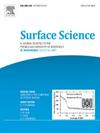Measurement of surface segregation via He+ ion scattering in CuxAgyAu1-x-y composition spread thin films
IF 2.1
4区 化学
Q3 CHEMISTRY, PHYSICAL
引用次数: 0
Abstract
Surface segregation under UHV conditions was mapped out across CuxAgyAu1-x-y (x = 0→1,y = 0→1‐x) composition space and over a temperature range of 500 – 800 K. E-beam deposition of Composition Spread Alloy Films (CSAFs), high-throughput SEM-EDX, XPS and LEIS experiments were performed to study the relationship between the alloy surface composition and bulk alloy composition. Strong depletion of Cu was observed across all alloy compositions, with <1 % surface Cu detected in alloys containing >20 % bulk Ag or >60 % bulk Au. The majority of the composition space is represented by AgAu surface alloys, showing weak Ag enrichment in alloys with low bulk Cu compositions (<25 % Ag enrichment) and significant Ag enrichment in alloys with higher Cu content (∼75 % Ag enrichment). Surface enrichment of Au in Cu was only observed in alloys with <5 % bulk Ag. These observations are quantitatively consistent with prior studies of the relevant binary alloys and qualitatively consistent with surface segregation driven by differences in surface energies. Alloys with surface Cu greater than 1 % were found to have temperature dependent segregation, varying by as much as 15 % surface Cu over the temperature range 500 – 800 K, while all other alloys showed negligible differences.

利用He+离子散射测量CuxAgyAu1-x-y成分扩散薄膜的表面偏析
在特高压条件下,通过CuxAgyAu1-x-y (x = 0→1,y = 0→1‐x)组成空间和500 ~ 800 K的温度范围绘制了表面偏析图。通过电子束沉积复合扩散合金薄膜(CSAFs)、高通量SEM-EDX、XPS和LEIS实验,研究了合金表面成分与本体成分之间的关系。在所有合金成分中都观察到Cu的强烈损耗,在含有20%大块银或60%大块金的合金中检测到1%表面Cu。大部分成分空间以AgAu表面合金为代表,在低体积Cu成分合金中表现为弱Ag富集(<; 25% Ag富集),而在Cu含量较高的合金中表现为显著Ag富集(~ 75% Ag富集)。Au在Cu中的表面富集仅在体积银含量为<; 5%的合金中观察到。这些观察结果在数量上与先前有关二元合金的研究一致,在质量上与表面能差异驱动的表面偏析一致。表面Cu大于1%的合金发现存在温度相关偏析,在500 - 800 K温度范围内,表面Cu变化高达15%,而所有其他合金的差异可以忽略不计。
本文章由计算机程序翻译,如有差异,请以英文原文为准。
求助全文
约1分钟内获得全文
求助全文
来源期刊

Surface Science
化学-物理:凝聚态物理
CiteScore
3.30
自引率
5.30%
发文量
137
审稿时长
25 days
期刊介绍:
Surface Science is devoted to elucidating the fundamental aspects of chemistry and physics occurring at a wide range of surfaces and interfaces and to disseminating this knowledge fast. The journal welcomes a broad spectrum of topics, including but not limited to:
• model systems (e.g. in Ultra High Vacuum) under well-controlled reactive conditions
• nanoscale science and engineering, including manipulation of matter at the atomic/molecular scale and assembly phenomena
• reactivity of surfaces as related to various applied areas including heterogeneous catalysis, chemistry at electrified interfaces, and semiconductors functionalization
• phenomena at interfaces relevant to energy storage and conversion, and fuels production and utilization
• surface reactivity for environmental protection and pollution remediation
• interactions at surfaces of soft matter, including polymers and biomaterials.
Both experimental and theoretical work, including modeling, is within the scope of the journal. Work published in Surface Science reaches a wide readership, from chemistry and physics to biology and materials science and engineering, providing an excellent forum for cross-fertilization of ideas and broad dissemination of scientific discoveries.
 求助内容:
求助内容: 应助结果提醒方式:
应助结果提醒方式:


